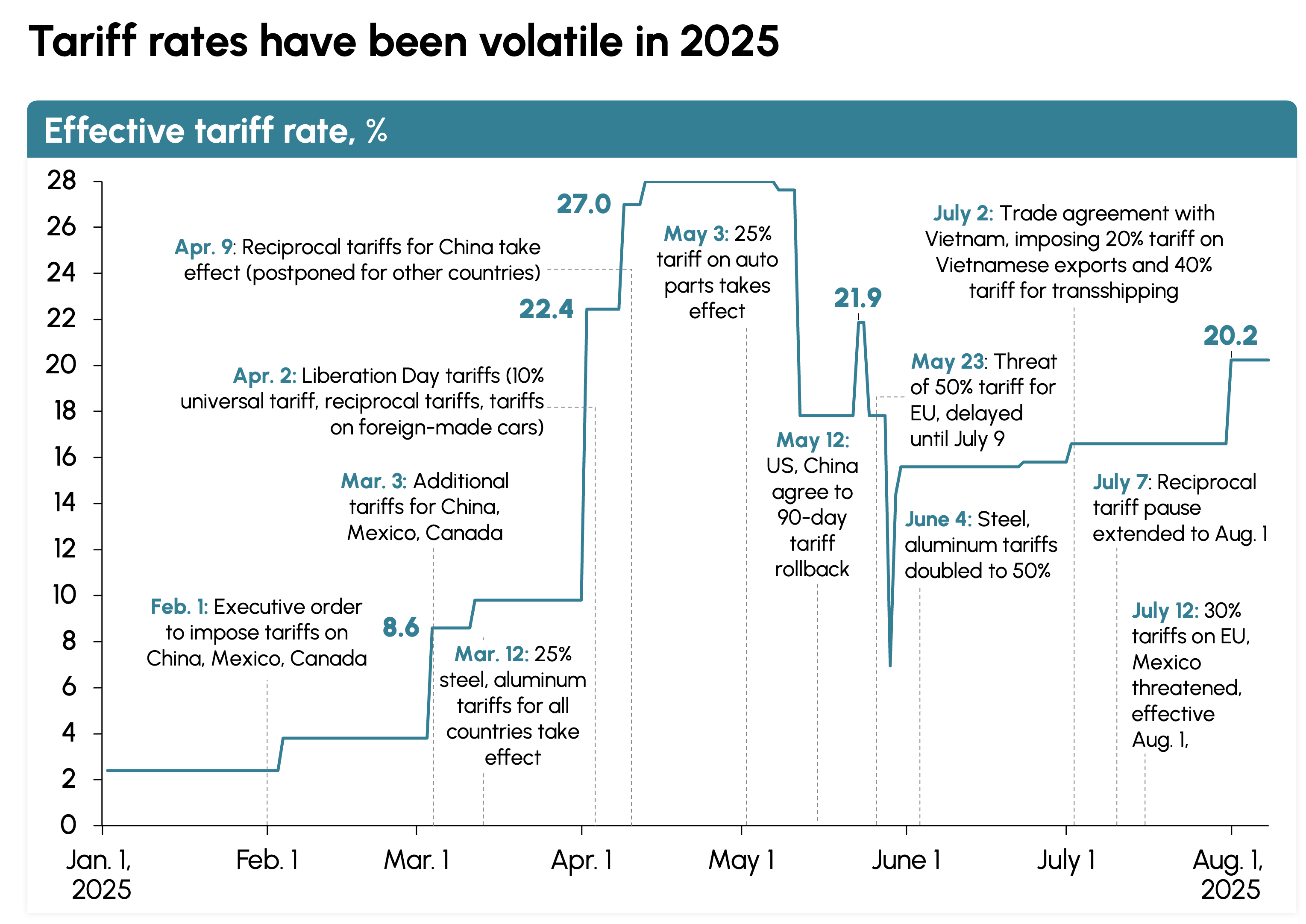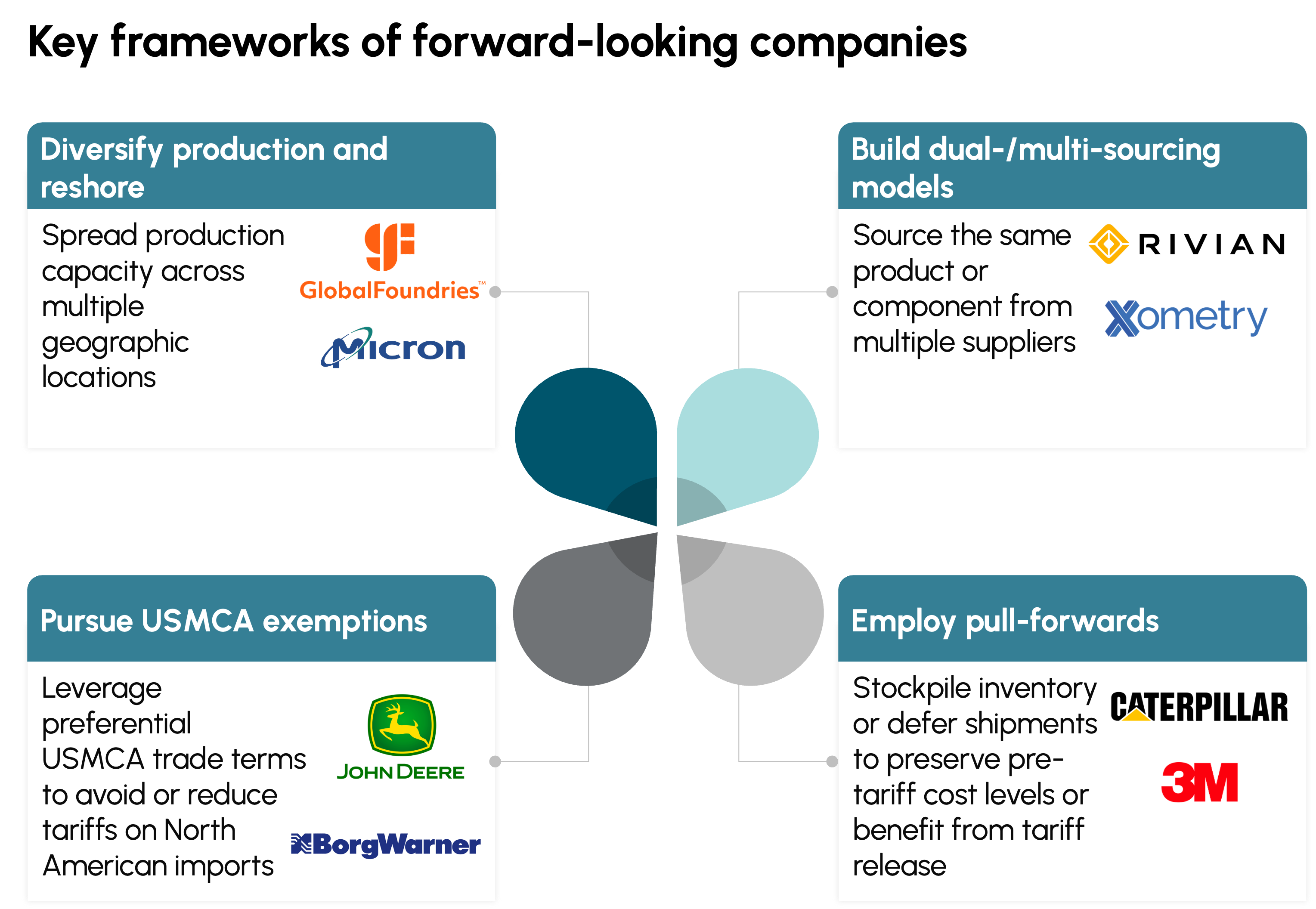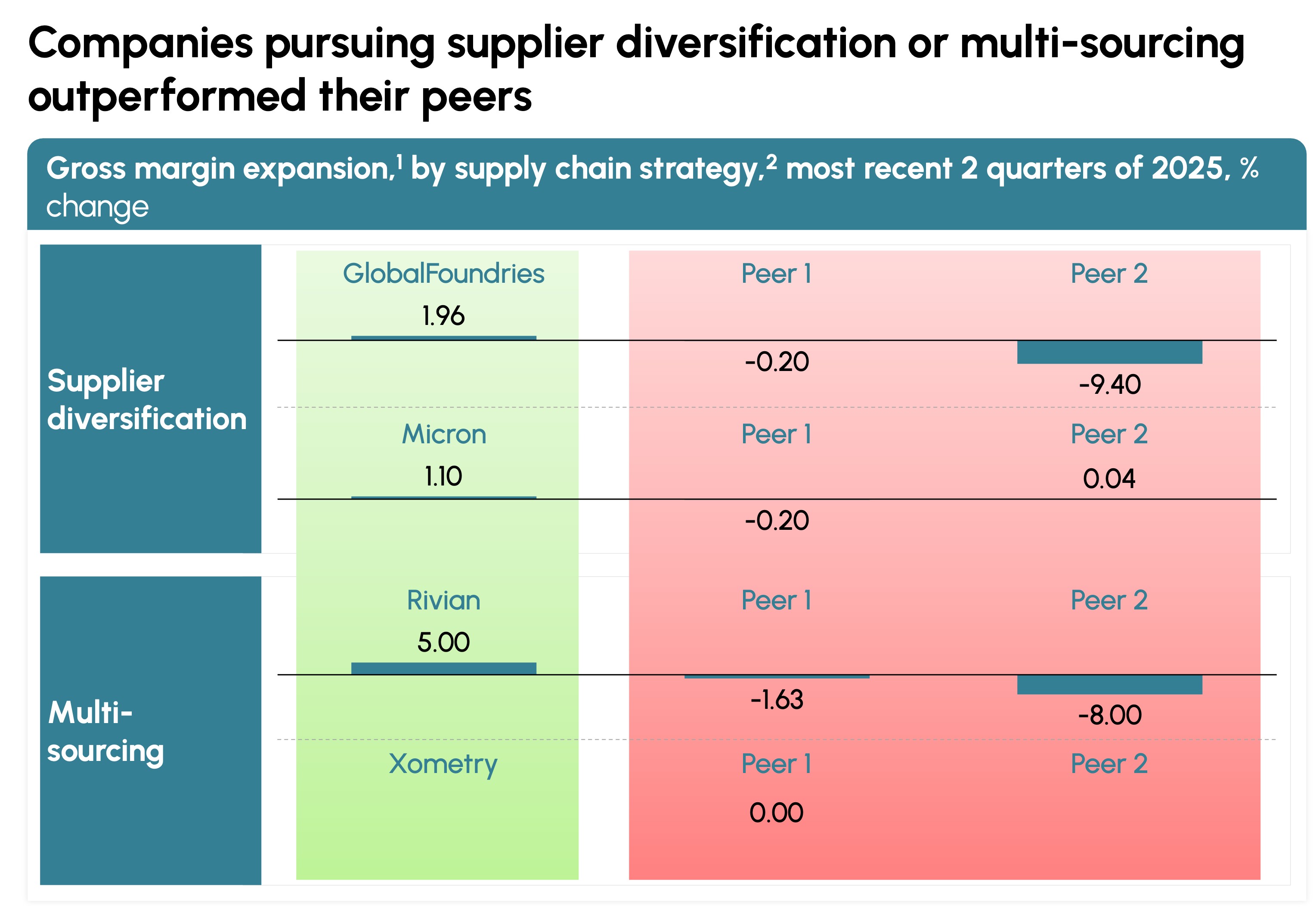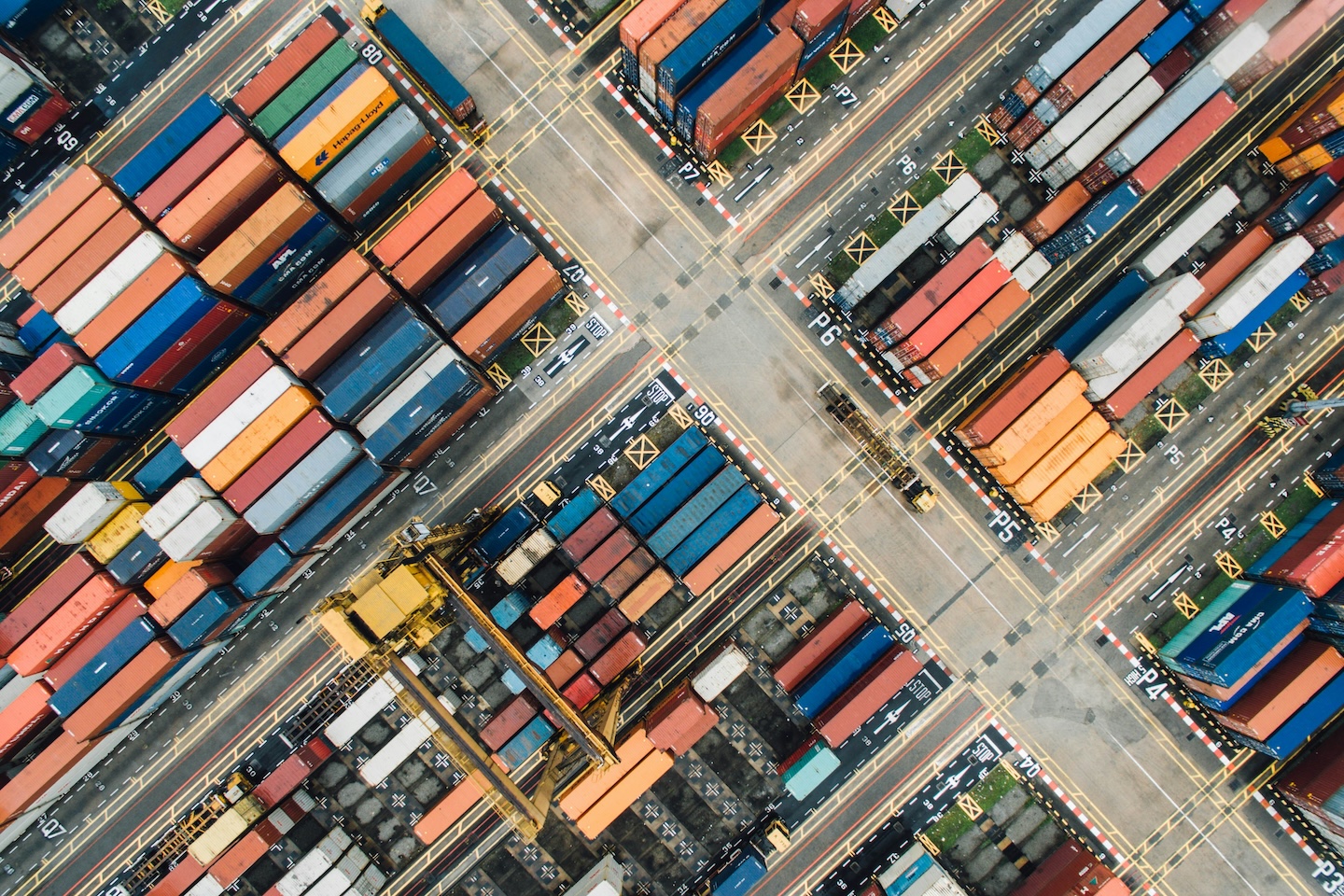Rarely has the resilience of global supply chains been tested as it has been during the past five years. Supply chains have been beset by a cascade of disruptions: COVID-driven shortages in 2020, port bottlenecks in 2021, inflationary shocks in 2022–23, and now a sweeping tariff regime enacted by the US government. This latest challenge stands out for its magnitude and scope. Furthermore, unlike the first three disruptions, the tariff policy is structural and intentional, so it is more likely to persist.
The business response has been mixed. Some operationally strong companies have been burdened by global supply chains that offer little flexibility in the face of shocks. Other companies have seized the moment to increase their options and build resilience. Advanced Energy Industries accelerated plans to shift production out of China as early as the second quarter of 2025.1 Caterpillar leveraged existing dealer inventories to defer tariffed shipments, dampening a projected $350 million cost hit.2 Builders FirstSource, with a disciplined sourcing model and only 15% reliance on imports for raw materials, has managed to blunt the impact altogether.3
The takeaway is clear: Companies focused only on whether to absorb the cost or pass it through are at risk of falling behind. Those who embrace the tariff volatility as a catalyst to increase their resilience—rethinking supplier footprints, rebalancing sourcing, and making strategic investments in agility—are positioning themselves to emerge stronger. In today’s policy environment, firms must treat resilience as a strategic asset. This article explores how the new normal is taking shape and how businesses can respond strategically.
The 2025 Tariff Shock
Compared with prior tariff policy and practice, the 2025 tariff shock stands out for its magnitude, volatility, broad scope, and structural intent.
- Nearly unprecedented magnitude. As of July 2025, the US effective tariff rate stands at 19%, its highest level since the Smoot-Hawley era of 1933. For context, average tariff rates hovered between 2.5% and 4.0% through most of the 21st century, peaking briefly at just 3.0% during US–China trade disputes in 2019.4
- Volatile execution. The execution of the current tariff regime has been extremely volatile. Effective rates have swung from 4% during initial announcements in February to 27% during peak tariffs announced on April 2 (Exhibit 1). On that day, declared Liberation Day, the announced tariffs included a 10% tariff on all countries, tariffs on foreign-made cars, and a set of additional tariffs referred to as “reciprocal.” Other tariffs, such as a 50% tariff on imports from the European Union, were announced but later postponed.
- Exhibit 1

- Broad scope. The tariffs’ impact is widespread and growing. For the top 10 US trading partners, if these tariffs had been imposed on their 2024 exports, an average of 74% of their exports to the United States would have been subject to new tariffs.5 Assuming a similar pattern continues, the tariff impact on importers from these countries will be widespread, possibly discouraging future sales to US markets. Significantly for US buyers, these trade partners provide key inputs, including machinery, plastics, wood, and aluminum.
- Structural intent. The current administration has cited multiple reasons for imposing tariffs, among them national security and economic sovereignty. One motivation for the tariffs stands out for already delivering on the promise: Tariffs deliver tax revenue to the federal government. In the first 144 days of 2025, the collection of tariffs and excise taxes brought in more than $126 billion, far above any of the previous eight years. In June alone, customs duties hit $27 billion, putting the year on track for a record $300 billion in tariff collections.
The Trouble with Tariffs
Over the past decade, the mere whisper of new tariffs has reliably triggered stock sell-offs, reduced guidance, and defensive earnings calls. In 2025, the most common responses reported by companies include price hikes and withdrawal of guidance. As of July 21, 2025, 68 US companies reported withdrawing or cutting guidance, 22 said they raised prices, and 30 announced financial hits to their bottom line.6 By industry, companies in the industrial and manufacturing sector more frequently report price hikes, financial hits, and changes to their supply chain.
However, the traditional playbook—raise prices, delay shipments, and renegotiate contracts—is wearing thin. Firms with rigid supply chains have a hard time shifting away from existing suppliers, so their cost of sales tends to rise. This lack of flexibility brings about the financial impacts and margin warnings associated with tariffs.
At Resilient Companies, Tariffs Trigger Action
The recent tariffs differentiate companies with rigid supply chains from those that plan for flexibility. The latter companies can redesign supply chains, reduce risk, and unlock future value, positioning themselves to outperform their less agile peers. Resilient and diversified supply chains are becoming essential for long-term competitiveness. Companies that recognize this are already separating from the pack by diversifying production and reshoring, building dual- or multi-sourcing models, pursuing USMCA exemptions,7 and employing pull-forwards (Exhibit 2).
Exhibit 2

The most impactful efforts are to diversify suppliers and reshape sourcing. Companies diversify risk by sourcing through various channels, and firms that can reshore and vertically integrate bring their supply back home. These efforts reinforce firms’ supply chains. The bottom line is increased predictability and typically lower cost of revenue.
All firms have the capability to diversify their supply base and establish multi-sourcing models. Companies doing so have been able to weather the tariffs with stronger operating performance in terms of gross margins relative to their peers (Exhibit 3).
Exhibit 3

These efforts have impact because, in most businesses, risk is too heavily concentrated in certain channels, and supply chains are inflexible. In contrast to uncontrollable supply chain crises, such as inflation or the supply constraints that arose because of COVID-19, the US tariff regime is more malleable, so it can serve as a wakeup call to insulate against risk. Now is the time for firms to focus more on supply chain design so they can protect themselves from future threats.
***
The 2025 tariff regime is a structural reset, not just a passing policy shift. Traditional responses like price increases and cost absorption buy time but ultimately erode competitiveness. Leaders must frame tariffs as a stress test to be learned from—one that reveals fragilities, exposes overdependence, and may unlock new sources of resilience.
Trade flows with major partners are unlikely to return to pre-2020 norms anytime soon. Now is a critical time for action: urgently identifying near-term alternatives in Southeast Asia, leveraging trade benefits like USMCA exemptions, and auditing cost structures at a granular level. Above all, the moment calls for a mindset that sees resilience as a cross-functional responsibility and strategic differentiator.
The lesson for industrial leaders is clear: By treating tariffs as a catalyst for transformation, businesses can not only survive the volatility but also lead through it.
1 Stephen Kelley, “Advanced Energy Industries, Inc. (AEIS) Q4 2024 Earnings Transcript,” January 17, 2025.
2 Joseph Creed, “Caterpillar Inc. (CAT) Q1 2025 Earnings Transcript,” April 30, 2025.
3 Peter Jackson, “Builders FirstSource Inc. (BLDR) Q1 2025 Earnings Transcript,” March 31, 2025; Pete Beckmann, “Builders FirstSource Inc. (BLDR) Q1 2025 Earnings Transcript,” March 31, 2025.
4 “State of U.S. Tariffs: July 23, 2025,” The Budget Lab, Yale University, July 23, 2025, https://budgetlab.yale.edu/research/state-us-tariffs-july-23- 2025.
5 Top 10 based on exports as a share of country’s total 2024 exports. The countries are Mexico, Haiti, Canada, Costa Rica, Jamaica, Liberia, Cambodia, Nicaragua, Trinidad and Tobago, and the Dominican Republic. Elisabeth Buchwald, Rachel Wilson, Amy O’Kruk, and Eleanor Stubbs, “Timeline: What to Know about Trump’s Global Tariff Rollout,” CNN Business, updated August 8, 2025, https://www.cnn.com/business/tariffs-trump-timeline-dg.
6 “How Companies Are Responding to Trump’s Tariffs,” Reuters, July 21, 2025, https://www.reuters.com/graphics/USA-TRUMP/TARIFF-COMPANIES/movadjkmnpa/.
7 Tariff exemptions for trade covered by the United States–Mexico–Canada (USMCA) trade agreement.






















